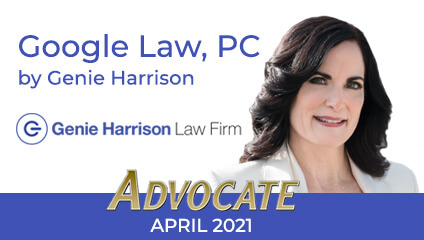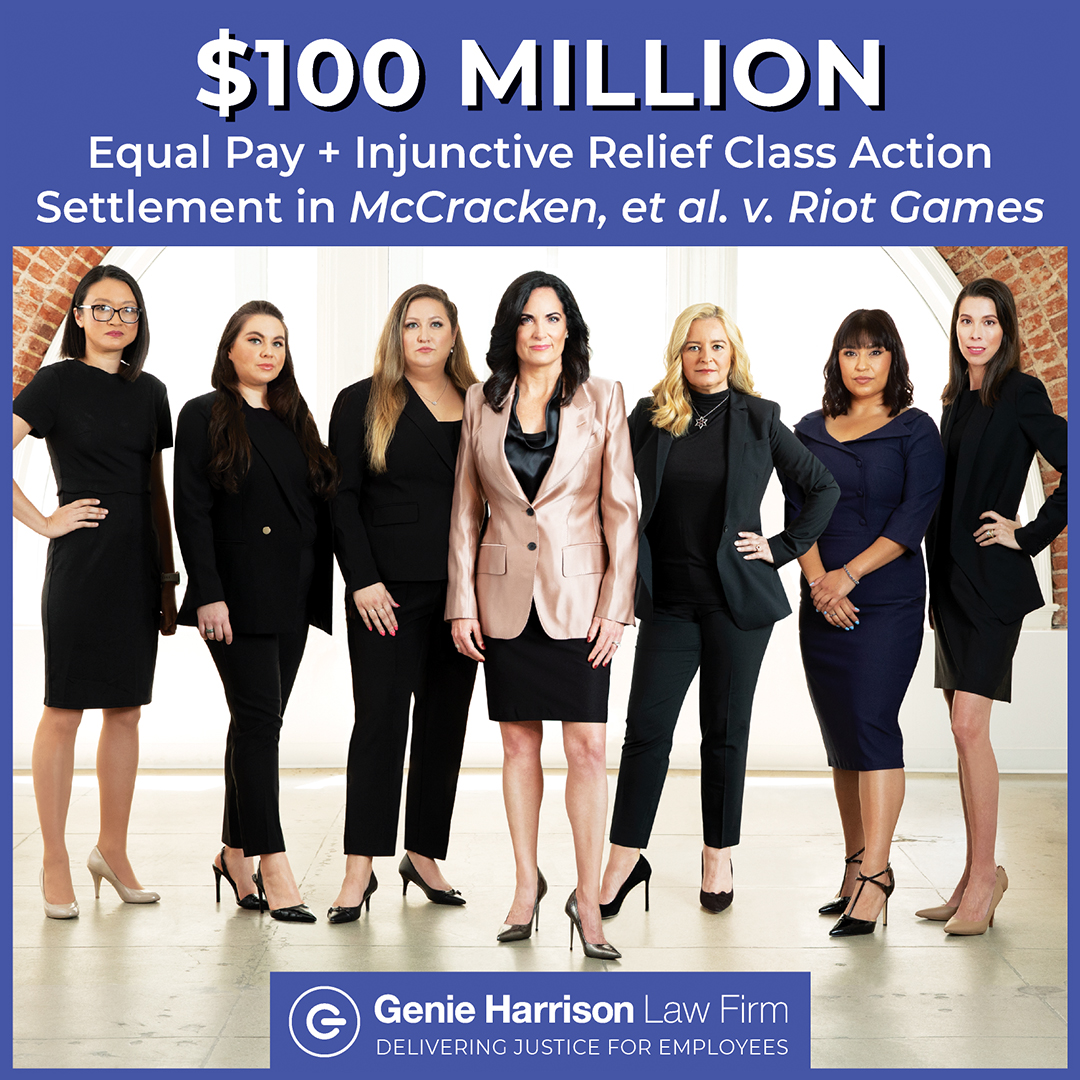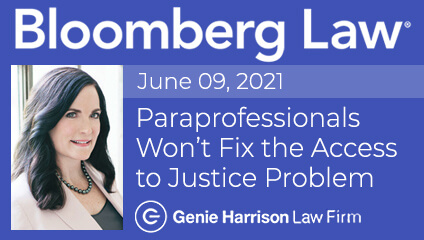
Google Law, PC
by CAALA President Genie Harrison for The Advocate, April 2021
The State Bar plans to bring non-lawyers into the practice of law. It’s time for you to become involved.
Google Law Firm, PC. Amazon Law, LLC. Mercury Insurance Law, Inc. That list of hypothetical law firms may read like a bad dream, but non-lawyer ownership of law firms is coming, and the extent to which they take over the legal business is up to you.
Consumer attorneys, who fight for individual rights and corporate accountability, have been the bulwark against corporate, take-no-prisoners, profit machines. But – and I cannot stress this strongly enough – the fight against non-lawyer ownership of law firms and paraprofessional representation in court may be our last stand. Your choice to act or not will have long-lasting ramifications.
How did it come about that the State Bar, to which we each must pay annual dues, is trying to deregulate the law business? A bit of history is in order.
On January 1, 2018, the State Bar split from the voluntary bar association and substantive law sections that were part of the organization. The voluntary bar association sections are now known as California Lawyers Association. The State Bar’s mission “is to protect the public and includes the primary functions of licensing, regulation and discipline of attorneys; the advancement of the ethical and competent practice of law; and support of efforts for greater access to, and inclusion in, the legal system.”
The State Bar’s Updated 2017-2022 Strategic Plan outlines that, in the alleged furtherance of the “access to justice objectives,” it would (1) “study online legal services delivery models;” (2) “complete a California Justice Gap Study;” and (3) “explore options to increase access through licensing of paraprofessionals, limited license legal technicians, and other paraprofessionals.”
The “Justice Gap”
In 2019, the State Bar issued a “Justice Gap Study,” based on a survey of California residents conducted by NORC (National Opinion Research Center) at the University of Chicago. The survey questioned 3,885 Californians “with incomes at or below, and those above, 125 percent of FPL [federal poverty level], and specific demographic groups: seniors (65 and older), those living in rural areas, veterans, people with disabilities, and survivors of sexual assault or domestic violence.” The survey concluded that 55% of respondents experienced at least one civil legal issue in the year preceding the study. “Health, finance, and employment were the main legal problem types” identified in the survey.
• Health issues included problems getting health insurance, issues with debt collection, and payment for necessary equipment.
• Financial issues included problems getting credit due to identity theft, being the target of unfair lending practices, problems with credit repair services or payday lenders, harassment by creditors, repossession of a car, and disconnected utilities.
• Employment issues included non-payment of wages, denial of worker’s compensation, unsafe working conditions, unfair termination, denial of accommodation, denial of unemployment benefits, inadequate handling of workplace grievances, and sexual harassment.
This “justice gap” may sound dramatic but consider an example. In response to questions about employment issues, 123 respondents surveyed said they encountered employment problems. Sixty-six people, or just over half of those respondents, said they sought legal help for their employment issues, and half of them obtained the legal help they sought. Only 12 people, or 21% of those who sought help, said they did not get any help because of cost.
The State Bar latched on to the Justice Gap Survey results, as paltry as they were, to justify a radical shift in California’s legal business model, creating a regulatory sandbox non-lawyer ownership of law firms and a paraprofessional program. Simply put, Justice Gap study is now the basis for the deregulation of the entire legal business model in California. Implementation of the deregulation plan is occurring through two State Bar groups, Closing the Justice Gap Working Group and the Paraprofessional Program Working Group.
The Closing the Justice Gap Working Group is creating recommendations for (1) a regulatory sandbox; (2) changing advertising and solicitation rules to allow “innovation and access to legal services;” (3) changing lawyer referral service statutes and rules to promote “innovation and access to legal services;” and (4) amendments to rule 5.4 of the California Rules of Professional Conduct regarding attorney fee sharing with non-lawyers.
The Paraprofessional Program Working Group
State Bar Paraprofessional Program Working Group (PPWG) is developing recommendations “for the creation of a paraprofessional licensure/certificate program.” The PPWG is determining the requirements and practice areas for licensure, the tasks that paraprofessionals will be allowed to perform, and the business requirements for the new legal practitioners (like the number of required specialty training hours, ability to take referral fees and work on a contingency basis, or the obligation to maintain malpractice insurance).
It’s not “if”…
To be clear, the State Bar is implementing these programs. There is no way to prevent them, so the question is how best to limit them to protect consumers.
Micha Star Liberty, former CAOC President, is on the closing the Justice Gap Working Group but is only one of twenty, and is outnumbered by members who want the program to be as broad as possible. Can we even doubt the outcome? Consider that four out of twenty members of the Closing the Justice Gap Working Group aren’t even California residents – they reside in Arizona, Utah, Washington DC, and the UK, where big tech’s takeover of the legal business has made serious inroads.
Carolin Shining, a CAOC and CAALA member, is on the PPWG Committee but is also outnumbered.
The Closing the Justice Gap Working Group is having regular meetings. There are a few dozen Committee and Subcommittee monthly meetings of the PPWG. Attorneys from nonprofits, including Public Counsel, Bet Tzedek, Legal Aid at Work, etc., CAALA and CELA have attended numerous meetings, successfully arguing to limit the paraprofessional program. But this resistance work is time-consuming. The Committees and Subcommittees need to see that many lawyers across the state are mounting a vigorous defense.
Get involved and stay involved
This brings me to you – we need you to get and stay involved. You can attend Committee and Subcommittee meetings, all via Zoom. Speak up during public comment, which usually happens at the beginning of each scheduled meeting and lasts only about two minutes per person. The State Bar posts meeting dates ten days ahead, and you can find the schedule at https://board.calbar.ca.gov/Committees.aspx. Our goal is to have a large group of plaintiff lawyers present at each meeting to show that we will oppose the State Bar in every way possible.
Self-professed “consumer-driven” legal industry “disruptors” are aiming to take over the business of law which is not just the fox guarding the henhouse. It’s more like the fox buying the land on which the henhouse sits, raising and feeding the hens, then slaughtering and serving them up for dinner. While the owner of the land, breeder, and purveyor of chickens can claim that its business is fair and humane, the business purpose is still the same.
The fact is that not even the wealthiest of plaintiff lawyers can compete with Google Law advertising or expect to rank in search results. And the fair value of cases, regardless of type, established by the adversarial system will be substantially compromised when corporations own both the plaintiff and defense law firms.
I hate to be the bearer of bad news, but I hope you see that it’s time to get involved, or else your State Bar dues might soon be more than the value of your license.





